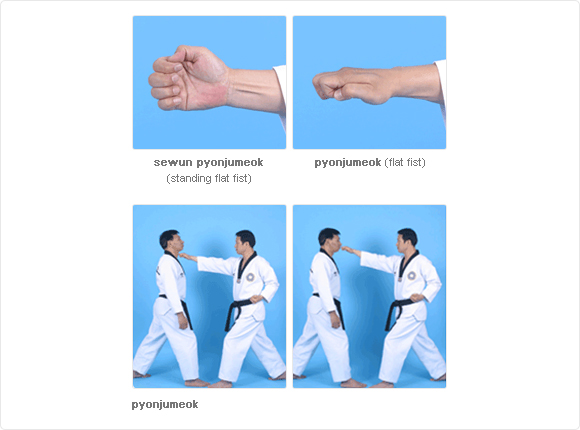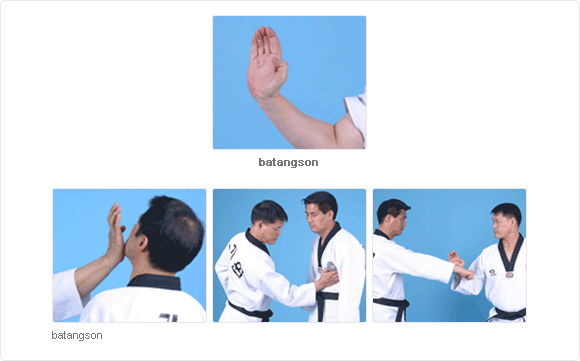One of the first basic techniques in Taekwondo, is the jumeok or fist. Usually the jumeok (fist) is formed by clenching the fingers and its forms are broken down into 6 main types, according to its usage in Taekwondo techniques : Jumeok (fist), Deungjumeok (fist back fist), Mejumeok (hammer fist), Pyonjumeok (flat fist), Sosumjumeok (knuckle protruding fist) and Jipkejumeok (pincers fist). The jumeok in Taekwondo is a simple form of fist clenching the fingers firmly folding into the palm and only the fist joint parts of first finger and middle finger are used for punching. 1. The way of forming:
- unfolded the palm of the hand
- starting finger-tips to clench
- clenching finger-tips to first finger joints
- covering fingernail invisibly
- clenching pincers and middle fingers with the thumb
2. Usage:
- A jumeok is applied to the punch technique.
3. Precautions:
- The fist should not be bent at the wrist but kept on a straight line between the fist-back and the fore-arm-back.
- An extended line in between the knuckles of forefinger and middle finger must be kept on a straight line with the forearm.
- The hand-back and the first-joints of clenched fingers should form a right angle.
- It is not easy to make a right form of this fist, naturally requiring strenuous efforts.
Deungjumeok (fist back fist)
1. The way of forming: The same as the forming of a simple fist but the only difference is its usage. This time, the back of the fist is used for attacks. 2. Examples of application are shown in the photos below, back-fist face front hit and back-fist face outside hit.
Mejumeok (hammer fist)
1. The way of forming: The same as a fist, but only the little finger side is used. (Photos show meori-naeryochigi, palkupkwanjol-naeryochigi and yopkuri-bakkatchigi, respectively meaning a pounding hit on the head, a pounding hit on the elbow joint and a hit on the trunk flank). 2. Usage: Same as the fist-back fist.
Pyunjumeok (flat fist)
1. The way of forming: First, follow the same process as in forming a jumeok by rolling the clenched fingers toward the palm up to the second finger joints, but keeping the third joints slightly bent at an interior angle of 160 degrees. Then the thumb will be attached lightly to the second joint of forefinger. 2. Applicable parts: The foremost part of pyonjumeok, i.e., the second joints of fingers will be used for attack purposes. It reaches longer than the simple jumeok and, with a practice of hardening, it can deliver strong attacks. 3. Usage: Like a jumeok, it is used as one of punch techniques, but sometimes it can be also used in scratching the target.
Sosumjumeok (knuckle protruding fist)
1. The way of forming: This type of fist resembles a fist but just like holding a walut inside the jumeok :therefore, the second joint of middle finger protrudes forward by keeping the first joint slightly bent down and the third joint supported by the thumb tip so that the middle finger may not be pushed back.Applicable part : the second joint of middle finger. 2. Usage: This is used in a punch attack like a jumeok, but pierces deeper than jumeok, inflicting a vital blow. It is also used as a lethal weapon technique. (see the photos below)
Jipkejumeok (pincers fist)
1. The way of forming: With the form of a jumeok, the thumb and the forefinger are held open apart from each other, the other fingers remaining clenched. 2. Applicable part: The thumb and the forefinger in an arc hand shape play the role of pincers. 3. Usage: The jipkejumeok functions in a punch technique, but at the same time the two pincer fingers grasp and tear off the target. It is generally used to punch the gullet and simultaneously hackle it with the tips of two pincer fingers. 4. Precaution: At the time of attack, the jipkejumeok should be kept in and erect position, an after the punch the pincer fingers simultaneously pull down the gullet in a reaction of the motion when the fist retreats. (see photos below.
Son (hand)
The “son”(hand) in Taekwondo means an open hand, only the fingers slightly crooked at their third joints. Its applicable parts double those of the fist and vary according to the targets. 1. The way of forming:
- Flat hand, stick the four fingers side by side, keeping their last joints crooked inward slightly.
- Then attach the thumb slightly crooked at the first joint to the base of forefinger.
2. Applicable part: The little finger side from its first tip down to the wrist. 3. Usage: The sonnal is used for both chigi (hit) and makki (defense) techniques. (see photos) 4. Precaution: In a sonnal form, the hand must be kept in a straight line with the forearm, never crooked either upward, downward, inward or outward.
Sonnaldeung (hand-blade back)
1. The way of forming: The same form of sonnal except for the thumb deeply buried inside the palm. 2. Applicable part: The first joint of thumb and the base of the forefinger. 3. Usage: Mainly applied to the chigi and makki techniques. (see photos) 4. Precaution: It must be stressed to keep the thumb buried deep into the palm.
Sondeung (hand-back)
1. The way of forming: The same as the form of sonnal, but the sondeung may keep the fingers relatively loose. 2. Applicable part: All parts of the hand from the finger’s back to the hand back. 3. Usage: This is used principally as a chigi technique for a momentary attack at a close distance. 4. Precaution: At the moment of attack, the sondeung must accompany a repulsive reaction. (see photos)
Pyonsonkkeut (flat hand tips)
1. The way of forming: The same as the form of sonnal except that especially the forefinger, middle finger and ring finger are tightly attached side by side with their finger tips straightened in a line. 2. Applicable part: The finger tips of the above mentioned three fingers. 3. Usage: This is mainly used in tzireugi (thrust) techniques but also applicable to the “hulkki”(hackle) techniques.
- If the finger tips are trained hard, they are readily used in attacks. This makes the arm’s reach longer than the fist, thus enabling a vital attack.
- There are three positions of Pyonsonkkeut according to its usage in attacks, (a) sewun-pyonsonkkeut(an erect position of a sewo tzireugi), (b) jechin-pyonsonkkeut (raised-up position for a jecheo tzireugi), and (c) upeun-pyonsonkkeut (a reverse position for upeo-tzireugi, i.e., overturned tzireugi) (see photos).
Kawisonkkeut (scissor’s finger-tips)
1. The way of forming: The forefinger and the middle finger are stretched with the fingers opened apart from each other and the ring finger and little finger are rolled into the palm, the second joint of the ring finger supported by thumb. 2. Applicable part: The finger tips of both forefinger and the middle finger are used. 3. Usage: This is applied only to the tzireugi techniques, usually attacking the opponent’s both eyes. (see photos)
Hansonkkeut (single finger-tip)
1. The way of forming: Keep the forefinger stretched to look as if it points at something this time the thumb powerfully supporting the second joint of the crooked middle finger. 2. Applicable part: Only the tip of forefinger is used. 3. Usage: Mainly applied to thrust into one of the opponent’s eyes and able to stab other vital parts. (see photos)
Moundusonkkeut (combined two finger-tips)
1. The way of forming: Make the stretched forefinger overlapped by the middle finger, keeping the other fingers just as the kawisonkkeut did. 2. Applicable part: Combined two finger tips. 3. Usage: The same as the hansonkkeut (single finger tip)
- Moundusonkkeut exerts stronger power than hansonkkeut.
Mounsesonkkeut (conbined three finger-tip)
1. The way of forming: Gather the forefinger and the ring finger, laying the middle finger on them and keep the remaining two fingers attached together loosely. 2. Applicable part: The combined three finger tips.
- The combined fingers form a triangle.
3. Usage: The same as the hansonkkeut, but this is a variation of the flat hand tips, exerting stronger power than the latter.
Modumsonkkeut (all combined finger-tips)
1. The way of forming: Gather all five finger tips sticking togerther, then the first joints of all fingers except the thumb will bend inward a little. 2. Applicable part: All combined five finger tips. 3. Usage: This is used for a tzikki (chopping technique at a shorter distance than tzireugi thrust) technique.
Komson (bear hand)
1. The way of forming: Almost the same way as the pyonjumeok (flat fist) is formed except that all fingers excluding the thumb are crooked harder than the pyonjumeok. 2. Applicable part: The third joints of fingers. 3. Usage: This is mainly applied for chigi (hit) techniques, just hitting in the face. The chigi is made inward just as a bear scratches with its fore foot sole.
Batangson (palm hand)
1. The way of forming: Pull the hand slightly upward in the direction of the hand back, without straining it, and bend the fingers lightly without any tenseness. 2. Applicable part: The base of palm (toward the wrist). 3. Usage: This is used for a chigi (hit) and makki(defence) technique. The batangson is so wide that can not deliver vital parts; therefore, it is sometimes used for a makki (defense) technique.
Kuppinsonmok (bow wrist)
1. The way of forming: The opposite way of forming a batangson. The wrist is bowed fairly deep in the direction of the palm. The five fingers are lightly gathered together. 2. Applicable part: The wrist on the side of bowed hand back. 3. Usage: This is used largely for ollyeochigi (upward hit) or makki techniques. Unlike the batangson which reaches long to make jireugi (punch) techniques, the kuppinsonmok can be applied to a fairly short distance attack because of the bent elbow.
Agwison (arc hand)
1. The way of forming: Keep the thumb and the forefinger fairly wide open apart from each other and attach the four fingers other than the thumb side by side, slightly bending each joint of fingers so as to form a round shape. The forearm and the hand back must be kept in a straight line lest it should look like a batangson. 2. Applicable part: The hollow part between the forefinger and the thumb. 3. Usage: Usually this is used for chigi (hit) technique. The jaw or the neck are the best targets for the agwison in that they can fit the hollow of agwison. If one hits the lower part of jaw with the agwison, it is called “nakteok” and the motion of executing such a technique is called “khaljaebi”.
Palmok (forearm, especially the wrist part)
1. The way of forming: The forearm has a big and long bone, which makes it easily applied for defense purposes. Among others, the inner flank and the outer flank of the forearm are sharp enough to deliver attack techniques immediately after defending with either of them. However, the forearm base and the forearm back are wide so that they may be used in makki techniques and they are unable to inflict an offensive blow, rather being liable to suffer a fracture of boneif they are hit too hard. 2. Usage: The applicable parts of the forearm are bakkatpalmok (outer flank of forearm), anpalmok (inner flank of forearm), deungpalmok (back of forearm) and mitpalmok (base of forearm).
Palkup (elbow)
1. The way of forming: When inflicted at the joint, the elbow can be used to hit a nearer opponent mainly in chigi techniques such as dollyo chigi (spinning hit), ollyo chigi (lifting hit), naeryo chigi (pounding hit), yop chigi (lateral hit) and dwi chgi (backward hit).
























